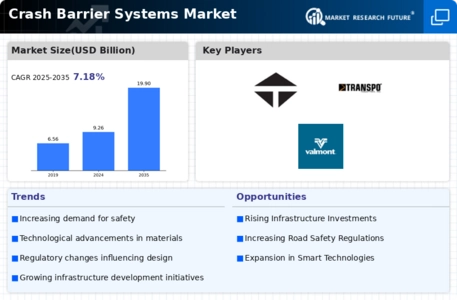Crash Barrier Systems Size
Crash Barrier Systems Market Growth Projections and Opportunities
Many market factors shape the Crash Barrier Systems market. Global road safety, especially on highways and busy roads, is a major driver. Crash barrier systems are in demand as governments and transportation agencies worldwide work to minimize road accidents and improve safety. Guardrails, crash cushions, and other protective obstacles reduce accident severity, protect drivers, and keep traffic flowing. Crash Barrier Systems are heavily influenced by government policy and infrastructure development. Crash barrier systems become essential to road safety strategies when governments fund transportation infrastructure projects. Stringent safety and regulatory requirements drive crash barrier system adoption toward advanced and compliance solutions. Advances in technology shape the Crash Barrier Systems market. Crash-resistant systems develop from barrier design, material, and manufacturing advancements. Sensors and smart technologies in barrier systems improve collision mitigation in intelligent transportation systems. Energy-absorbing barriers and other high-performance materials help the market meet safety needs. Environmental concerns are increasingly impacting Crash Barrier Systems materials and manufacturing techniques. Manufacturers are investigating eco-friendly materials as sustainability becomes more important. Green and recyclable barrier materials highlight a construction and transportation industry movement toward ethical and sustainable solutions. The Crash Barrier Systems market is also heavily influenced by building and real estate. To address urbanization and population increase, highways, bridges, and tunnels are built, increasing demand for crash barrier systems. The market is tightly related to construction and real estate trends due to the health of the construction sector and infrastructure development. The Crash Barrier Systems market is driven by economic factors including government infrastructure and road safety spending. Crash barrier systems are in demand during economic growth and construction expenditure. In contrast, economic downturns or budget constraints may reduce infrastructure construction, affecting crash barrier system sales. Road safety education and consumer awareness affect market dynamics. Effective crash barrier systems are in demand as road safety awareness rises. Governments, advocacy groups, and safety organizations educate the public about crash barriers, impacting purchase decisions and market growth. Market dynamics are shaped by crash barrier systems competition. Research and development help companies create new products, materials, and technology. To increase market share and influence crash barrier system adoption, strong cooperation with government agencies, construction enterprises, and transportation authorities are essential.






Leave a Comment